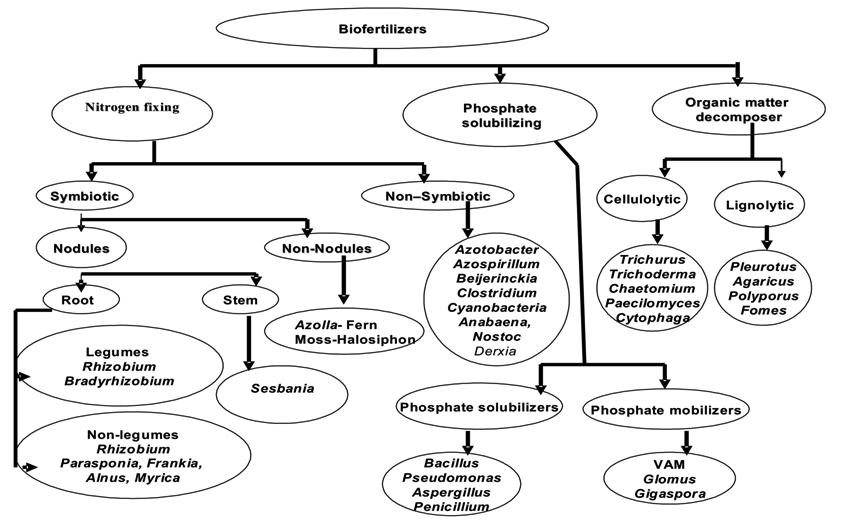कृषि क्षेत्र में जैव-आवेगों का योगदान
The increase in the world's population, coupled with the limitations in the world's supply of natural resources and widespread degeneration of the environment presents a major challenge to agriculturalists.
Chemical fertilizer is used to give the plant nutrient requirements within a short period to get faster results. Newly improved varieties of crops need high proportions of fertilizer. But chemical fertilizer has certain limitations and entails a lot of disadvantages. No doubt, the application of chemical fertilizer provides nutrition in high concentration in the soil and plants. When chemical fertilizer is applied, the entire contents would not be absorbed by the plants and the remaining parts would react in the soil. Part of it would be washed away and would contaminate water and some part of it would evaporate to the atmosphere; thereby the environment is polluted.
Intense activity is involved in efforts to create plants that by themselves are able to fix nitrogen from the atmosphere i.e convert nitrogen gas into nitrates that can be used by plant’s metabolic machinery. At present, only certain plants called legumes are naturally able to do so and even legumes require the aid of symbiotic bacteria.
Further soil is reservoir of nutrients. But in some cases the nutrient remain in fixed forms which are not easily accessible by plants, making the problem of nutrient deficiency persistent. In such scenario using microbial strains that can help in mineralization of soil bound nutrients makes nutrient acquisition by plants easier. Such a development would drastically curtail the amount of fertilizer required by agricultural crops.
The main factor is the price, biotechnology could provide an alternative to technologies that have harmful effects on the environment and it would have the potential of enhancing production on a sustainable basis. Microorganisms are useful for bio mineralization of soil bound nutrients and make nutrients available to their host and/or its surroundings.
Bio inoculants are individual strains or consortia of known microbes that have potential plant growth-promoting benefits added directly to the soil, or as a seed coating when re-seeding. Bio-inoculants are the potential agents to fight the major challenges of soil degradation, nutritional security, food security, climate change and sustainability.
Bio inoculants can complement chemical fertilizers for increasing crop productivity in a sustainable basis. Bio-inoculants contain beneficial microbes that enhance plant growth, when applied to the field, by the asset of its nutrient solubilization, nitrogen fixation, phytohormone production and induction of defense mechanism resulting in also improved soil health and productivity.
Many times bio-fertilizers and bio-inoculants are used synonomously. So the difference between bio-inoculants and bio-fertilizers, compiled from various sources are discussed as follows:
- Biofertilizers are substances which contain living microorganisms which, when applied to seed, plant surfaces, or soil, colonize the rhizosphere or the interior of the plant, and promote growth by increasing the supply or availability of primary nutrients to the host plant.
- Bio-inoculants are individual strains or consortia of known microbes that have potential plant growth-promoting benefits (Plant Growth Promoting Microorganisms; PGPM) added directly to the soil, or as a seed coating when re-seeding.
- Bio-inoculants are tailored formulations utilising current understanding of microorganism function to create bio-inoculants for a range of soil type and cropping systems.
- Bio-inoculants are formulations containing one or more beneficial microorganism strains (or species) prepared with an easy-to-use and economical carrier material.
So from the above discussions, it can be concluded that carrier based bio-inoculants are called as bio-fertilizers.
Importance of bio-inoculants
- Promote growth by increasing the supply or availability of nutrients to the host plant and also helps in suppressing disease causing pathogen.
- These are low cost, effective and renewable sources of plant nutrients that potentially supplement chemical fertilizers.
- It can improve nutrients uptake by plants and increase the use efficiency of applied chemical fertilizers and manures.
Classification of biofertilizer
Bio-fertilizers are classified into following categories based on different nutrient sources.

Major bio-inoculants used for plant growth
Given below is the list of certain bio-inoculants used for plant growth and development.
|
Bio-inoculants |
Target crops |
|
Rhizobium |
Leguminous crop |
|
Azotobacter |
Wheat, maize, cotton, mustard and vegetables (potato, onion, brinjal, tomato) |
|
Azospirillum |
Cereal crops like Wheat, Maize, Millets |
|
Gluconobacterdiazotrophicus |
Sugarcane |
|
Blue green algae (BGA) and Azolla |
Rice |
|
Phosphorus solubilizing microorganism (PSM) |
All crops |
|
Arbuscularmycorrhizal (AM) fungi |
Nursery raised crops and orchard trees |
Features of successful microbial strains:
- Rhizosphere competence.
- Potential for enhancing crop growth.
- Compatibility with other microbes.
- Ease for mass multiplication.
- Broad spectrum.
- Safety to the environment.
Mechanisms of nutrient acquisition
- Increase in the surface area of roots by extension of existing root systems (Mycorrhiza).
- Enhancement of root growth, branching and root hair development (By PGPR).
- By N fixation.
- Mobilization of nutrient.
- Displacement of sorption equilibrium.
- Turnover of microbial biomass within rhizosphere.
Authors
Ankita Trivedi1, Julius Uchoi1, Abhishek Kumar1, Sugan Meena1, Dileep Kumar1, Mavji Patidar1
1: Scientist, Central Arid Zone Research Institute, Jodhpur, Rajasthan- 342003
email:
